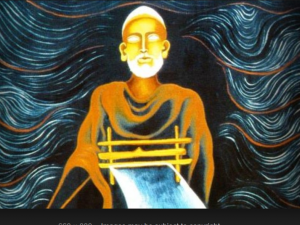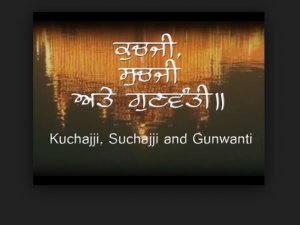As wedding season is in full swing in India, Ravin Kaur shares her thoughts on anand karaj along with some insights into the gurbani of laavaan.
Marriage is an ideal socio-religious relationship. In Sikhi, it is the formally recognized union of two people and the Guru. Ideally, the primary aim of marriage ought to be two partners helping each other merge with the Divine. Through marriage and possibly children, one can also learn that love entails selflessness; it is all about giving and sharing.
Within the Sikh community, the married state is seen as a norm. Many Sikh Gurus themselves entered into marriage and had a high regard for gristi-jeevan or “a householder’s life”. The Sikh faith discourages vows of celibacy, renunciation or ascetic living styles.
Marriage is also a spiritual experience. The Creator, the Divine, is silently showering us with gifts. There is only one gift that humans can give in return – their love and commitment. This they are empowered to withhold or return with gratitude.
The Sikh marriage focuses on both of these experiences. The fourth Guru, Guru Ram Das Sahib, originally composed the laavaan (Guru Granth Sahib, Ang 773) to celebrate a spiritual union between the human soul and the Supreme Soul. These now outline the basis of a successful marriage as they lay a strong foundation on which the bride and groom commit their two bodies as one soul to the Giver of life.
A marriage that is harmonious, but without Divine realization, may be an ideal sociocultural relationship at the human level, but falls short of being a spiritual marriage that commits to the Divine in terms of virtues, values and love.
In the Sikh tradition, marriage is a partnership of equals. It is also worth noting that, in principle, no consideration is given to caste or social status. No dowry is allowed. No day is considered as more auspicious than another for the wedding day. Hence no astrological considerations need to be made and no beliefs based on superstitions are to be observed in fixing the date of the wedding. (See the Sikh Rehat Maryada for more details.)
The religious ceremony takes place in the presence of Guru Granth Sahib. The fundamental part of the Sikh marriage ceremony, anand karaj or “blissful ceremony,” is the reciting and singing of shabads called laavaan as the couple circles Guru Granth Sahib. They go around Guru Granth Sahib four times. With each circumambulation, a shabad reminds them that the Guru is at the centre of their lives and from whom they will receive guidance on their journey together.
In this write up I will try to shed some light on the messages underpinning the marriage hymns that will provide the foundation for a successful marriage – worldly and spiritual.
The marriage ceremony begins with the first laav around the Guru Granth Sahib. By performing this round together, the couple accepts that the Guru is the centre of their lives. Here the Guru’s wisdom gives instructions for the conduct expected from the couple towards each other and towards members of their family as they engage in household activity. They are also to show their love for the Guru and Guru’s wisdom through rememberance of the Divine and right behaviour. The Guru’s words are a treasure of divine knowledge.
With knowledge of and through the practice of virtues such as truthfulness, compassion, contentment and gratitude among others, the couple move towards strengthening the bond with each other. Sinful behaviour is discarded, and gradually, behaviour that benefits others and uplifts the couple spiritually is adopted.
ਹਰਿ ਪਹਿਲੜੀ ਲਾਵ ਪਰਵਿਰਤੀ ਕਰਮ ਦ੍ਰਿੜਾਇਆ ਬਲਿ ਰਾਮ ਜੀਉ॥
Let us humble before the Divine! In the first round (stage), the Guru has set out the instructions for active social engagement (wedded life). – SGGS: 773
In the second laav – circumambulation around Guru Granth Sahib – the couple takes the next step in their relationship with the Divine and with each other. Through the Guru’s guidance they become conscious of Truth. The mind learns of the Divine presence in and around them at all times. Self-centredness is overcome and the mind becomes free of worldly fears and anxiety.
As egoism is eradicated, the mind is open to the Divine in all its awe. There is acceptance that the Divine is all around, inside and out, filling all spaces. Discarding the private space between them, the bride and groom come to share a common space of bliss with the Divine. Through divine praise, the heart is filled with mutual love and joy.
ਹਰਿ ਦੂਜੜੀ ਲਾਵ ਸਤਿਗੁਰੁ ਪੁਰਖੁ ਮਿਲਾਇਆ ਬਲਿ ਰਾਮ ਜੀਉ॥
ਨਿਰਭਉ ਭੈ ਮਨੁ ਹੋਇ ਹਉਮੈ ਮੈਲੁ ਗਵਾਇਆ ਬਲਿ ਰਾਮ ਜੀਉ ॥
Let us humble before the Divine! In the second round (stage), the Divine has led me to meet the true Guru and the mind has been freed of fear, and the filth of egoism eliminated. – SGGS: 773
In the third laav, another step is taken bringing the couple closer to the Divine. The focus is on the mind that is now becoming filled with spiritual joy. Love of and for the Divine is experienced in the company of like-minded and spiritually conscious beings. This connection with the Divine is strengthened further through the singing of divine praises in the company of these devotees.
As the mind fills with love and joy, this has to displace what has been in it before. Excessive sensual and emotional attachment to worldly objects has to be shed. There has to be detachment from excessive worldly entanglements. In this detachment too, there is an experience of joy as the mind comes to be filled only with the love of the Divine and no other.
ਹਰਿ ਤੀਜੜੀ ਲਾਵ ਮਨਿ ਚਾਉ ਭਇਆ ਬੈਰਾਗੀਆ ਬਲਿ ਰਾਮ ਜੀਉ॥
Let us humble before the Divine! In the third round (stage), the mind has been filled with spiritual joy and this has led to detachment (from worldly entanglements). –SGGS: 774
The fourth laav signals the attainment of spiritual union with the Divine. Through the light of divine consciousness, the devotee has met the Divine, who is sweet to both the body and mind. As the devotee lovingly focusses one’s consciousness on Waheguru, one is pleasing to the Divine too.
As divinity resounds and resonates within the devotee, the mind’s desire to be one with the Divine is fulfilled. The human soul has fused with divine consciousness and it brings the mind to a peaceful and serene state. Experiencing the Divine as all pervading, within the body and without, life is lived without pretense.
As consciousness of the Divine is manifested in life, there is peace and serenity.
ਹਰਿ ਚਉਥੜੀ ਲਾਵ ਮਨਿ ਸਹਜੁ ਭਇਆ ਹਰਿ ਪਾਇਆ ਬਲਿ ਰਾਮ ਜੀਉ॥
Let us humble before the Divine! In the fourth round (stage), a state of spiritual consciousness has welled up in the mind and I have found the Divine. – SGGS: 774
In summary, the Sikh marriage ceremony of bliss (Anand Karaj) is conducted in the presence of the Guru Granth Sahib. It is a sacred ceremony that binds a man and woman in a spiritual union. The spouse is a companion and an equal partner in the life’s journey – to strive to merge with the Divine.
The marriage ceremony encompasses a spiritual as well as a human dimension. On the one hand, the four ‘Laavaan’ represent the four steps the bride and groom, as one body, undertake to merge spiritually with the Divine. These steps have been explained in the hymns as written by Guru Ram Das.
A marriage is however, also a union of a man and woman as equal partners within contemporary society and a religious cultural setting. Let us now look at the four Laavaan in this context.
In the first laav, both are given the instruction to learn righteous conduct through the Guru’s wisdom and to contemplate on the virtues of the Creator who is our life force. Within the body is this treasure of the Naam (the Guru’s wisdom). The Divine abides within each of them. They need to uncover this wisdom which will then provide an awareness of a set of rules both should follow in their relationship with each other and with members of the extended family.
In the second laav, both are reminded to be conscious of the presence of the divine spirit in each other. Respect, reverence and appreciation of the Divine Source, relates also to respect for each other. The light of divine consciousness enables virtues such as truthfulness, compassion, contentment and gratitude among others to become part of everday life. These remove fear and the false ego from a relationship. Love for the Divine ignites love for the other.
In the third laav, the mind filled with love willingly detaches itself from worldly cravings bringing the couple closer together. In this loving communion of two souls, each partner helps one another to learn selflessness, faithfulness, giving and sharing. Man and woman look upon each other as reflections of the Divine within and give each other this due regard, the bond between them is further strengthened.
The fourth laav seals this union with the grace of the Divine as a witness shining upon them. Though physically two, they are now one in spirit. Oneness happens when each believes that the Divine has uniquely placed the two together in agreement with His will and with each other.
Marriage is about love. In the face of challenges and hardship, remember that marriage is a means of serving and glorifying the Divine together. It takes both the man and woman as one – working together – to truly reflect the virtues of the Divine.
Marriage is a step towards self-realization. We are all ‘one’ without knowing it. Once the ‘I-am- ness’ is removed, the egoism dispelled and the veil of materialism lifted, the pure self (the Divinity within) starts experiencing itself.
Dn ipru eyih n AwKIAin bhin iekTy hoie] eyk joiq duie mUrqI Dn ipru khIAY soie]
They who merely sit together are not said to be husband and wife. In fact, they who have one soul in two bodies are called true husband and wife. - Guru Amar Das,
Guru Granth Sahib, 788
The article has been extracted from one of AWAT issues, Messages of Laavaan.
Those who wish to receive the gems of Gurbani from AWAT can register
here: http://awordathought.com/
Compliled and Edited by
Ravin Kaur
Australia
By Ravin Kaur
Photo by Gurumustuk Singh





